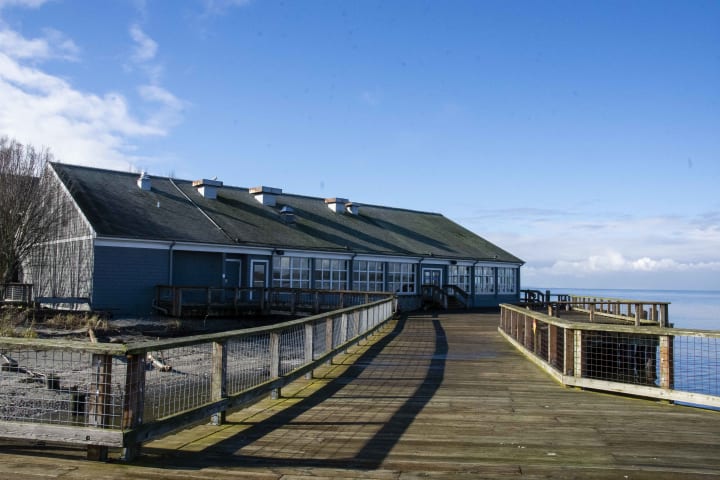When a Weekend Getaway Is Wild, Wet, and Beautiful
A Pacific Northwest adventure of the normal kind

Tiny droplets of ocean spray hit my face as I turn into the wind. I am bundled up warmly from head to toe; knit hat, quilted jacket, gloves, and warm socks inside my shiny red rubber boots.
The sun is at a quarter slant in the sky, for it has been up for hours. But we chose to rise leisurely before venturing out on this late winter morning. My partner and I have come up to Semiahmoo Resort for a long weekend and rejuvenation get-away.
Literally sitting on the edge of the Washington/Canadian border, this wild, wet, and beautiful area is a sanctuary in my home state. We don’t drive far or for hours but once we arrive, we feel transported to an easier, slower time, leaving the urban lifestyle behind.
Semiahmoo means “half-moon” in reference to the crescent shape of the bay which surrounds this spit of land. Originally occupied by the Semiahmoo First Nations tribe, they shared much of their rich culture and lifestyle with other Salish sea tribes along the inland Northwest coast. Living off the sea provided them with a rich bounty, salmon being the biggest staple in their diet.
We meander along the beach, walking our way down to what was once one of the old, salmon cannery buildings on this piece of land at the turn of the 20th century. Today, there is no longer a Cannery or a thriving fishing industry, only the buildings remain as our historical reminder, for now, the prosperous industry is, tourism. The building we head towards is now a historical museum, rich in tales and lore of the area and its colorful industry.
As we maneuver through the sand, rocks, and driftwood, we pause occasionally to watch flocks of shorebirds land, looking for their lunch. I walk a little closer to the lapping water and let the waves of Semiahmoo bay reach out and kiss my red rubber boots.
On the horizon, I spot a couple of crabbing boats bobbing up and down, and directly over my shoulder, in the opposite direction looms the majestic silhouette of Mount Baker. There are a few cumulous clouds floating around her peak and against the steel-colored sky, but her snow-covered crags are brilliantly white in the filtered sunshine. A sight to behold and a constant reminder of the natural beauty found in the Pacific Northwest backyard. If I fix my gaze northward, across the bay, I look directly at the city of White Rock, B.C., truly just a leap across the pond and the 49th parallel.
Semiahmoo Cannery Historical Museum

A white, utilitarian building from the outside, I almost walked right by the Cannery Historical Museum.
Pulling open its heavy door, we were greeted by Brian Solomon, the docent and for the next hour our personal tour guide through the four rooms of fishing history. His white beard and fisherman’s cap dressed him well as a descendant of a Nordic Viking or long-time captain of a sea vessel.
Brian’s stories were delightful, instantly capturing my interest in an industry and a people who walked these very beaches and gazed out on the same horizon watching the sunset beyond the Salish sea.
White explorers drifted in and out of this area, but it wasn’t until 1858 when prospectors came during the Fraser River Gold Rush that things began to change. They set up a trading post along the Semiahmoo spit with plans to continue further inland on their quest for striking it rich.
The area never really materialized into the boomtown early settlers envisioned but it did prove lucrative. Gold may not have been found but the salmon was, by the thousands. Semiahmoo quickly became an industry fishing town, with the first cannery opening in 1881 along its shores. From this inception, many small cannery businesses began to crop up until 1894, a company by the name of Alaska Packers Association bought out several of the moms and pops.
The Alaska Packers Association transformed the Semiahmoo spit into its primary area of operations, enlarging the cannery, adding warehouses, bunkhouse, and boat-repair shops. Most of these buildings' structures still exist, refurbished and resurrected into what is now the magnificent Semiahmoo Resort Lodge and Spa.
As we walked around listening to Brian take us back in time to the early 1900s, I reached out occasionally to run my hands across the heavily weighted, fishing nets and line, or trace over a processing machine with my palm. On the pine, planked walls in front of me hung black and white photos of young men pulling up nets loaded with thousands of salmon, tossing these marine giants through the air, and lining up along processing tables piled high with dead fish. Many of them, migrant workers, Chinese and Indian laborers working alongside burly fishermen who looked like they could be Brian’s ancestors. They all stared back at me through the frame as if to plead. “Don’t forget us.”
For almost an entire century, the salmon industry pulsed as the heartbeat of Semiahmoo. In 1981, the Alaska Packers Association closed its doors and the land eventually was redeveloped for the Semiahmoo Resort and Spa which opened in 1987.
A casual beach resort destination

Turning off Semiahmoo parkway and driving over the hill, the landscape opens up to a breathtaking view of the sea, mountains, and wildlife. The spit is a mile long, with the Resort and Spa sitting regally at the end of the road.
Known for its premier golf course designed by Arnold Palmer, Semiahmoo is also a truly relaxing getaway with a world-class spa, Olympic size, heated pool, and fitness club. They even have Yoga and Zumba classes if walking the beach becomes blaise.
In true Northwest fashion, the atmosphere is relaxed, casual, and come just as you are. The resort houses activities for everyone to enjoy, young and old, from an outdoor chessboard to pickleball to bird-watching guided tours. There are even smores cookouts by a beach bonfire in the evenings or Saturdays, join the wine tasting club for a sampling of four local and international wines. Are you a movie connoisseur? Because inside the resort is its own movie theatre with a movie run every Friday and Saturday evenings.
Today, the resort stands where the warehouse once stood and where there was once processing of salmon, to be canned and shipped all over the country. The main footprint of the buildings is the same, only refurbished with a new look and new life. Long gone are the days Semiahmoo was a fishing village. Today it is a four-star destination resort. But the past is not forgotten, in fact, it is integrated into every aspect of the resort.
Coming inside from the circular driveway, the first thing we notice is the beautiful pine wood. It is everywhere; on the beams, on the railings, even the concierge counter is made of beautiful pine woodwork. This too has been salvaged and repurposed from the original buildings which stood here, creating the feeling of a living legacy. The rustic luxury surrounding us, adds to the comfort of the lodge as we explore the various game rooms, reading areas, and eventually find our way to Packers Kitchen and Bar.
Gastronomy at Packers

Keeping the area's history pinnacle, Packers Kitchen is a nod to the Alaska Packers Association. In fact, hanging from the walls of this open-style eatery is memorabilia from the cannery days, reminding us the past is not that distant.
Packers Kitchen and Bar looks out onto the waterfront with a stunning view of Semiahmoo Bay from its floor-to-ceiling windows. I can’t help but wonder if any of those young men, hanging in the museum picture frames, looked out of these same windows and felt the same sense of awe in this wild beauty, as I felt in this moment. Even here, surrounded by the clink of dishes and the din of conversation I feel the connection to this land’s past.
Known for their seafood of course, is also a tribute to the heritage of this area but Packers also pays tribute to the present by using a wide array of local purveyors to source menu items. From local dairies and bread makers to farmers and brewmasters, they are keeping it local by sourcing from the artisans themselves and hand-selecting products directly from their fields. These items eventually wind up as delicious gastronomic delights on our plates. Their menu is flexible with an assortment of offerings for every taste, from the standard fish & chips to wood-fire pizzas. I was pleased to find many dietary options available, including Vegetarian, Vegan, and Gluten-free.
The sister restaurant to Packers is the Great Blue Heron Grill and can be found inside the Semiahmoo Golf and Country club.
All good things come to an end
Time became fluid as we lounged by the fireside in our room, strolled the sandy shore, or relaxed after laps in the pool. Eventually, the moment came to return to our normally scheduled lives. We did so replenished and enriched with the history, the sanctity, and the beauty of this wild, raw, and watery spit at the northernmost border of Washington state.
_____________________
Stay in touch and receive similar stories and tales from MaryRose directly to your inbox, here
Or follow me on my website MaryRoseDentonWriter. With much writing love,
MaryRose
About the Creator
MaryRose Denton
MaryRose Denton lives between mountains and water.
She believes in Meraki. That thing that happens when you leave a piece of your soul,in your work. When you love doing something, anything, so much that you put something of yourself into it.






Comments
There are no comments for this story
Be the first to respond and start the conversation.